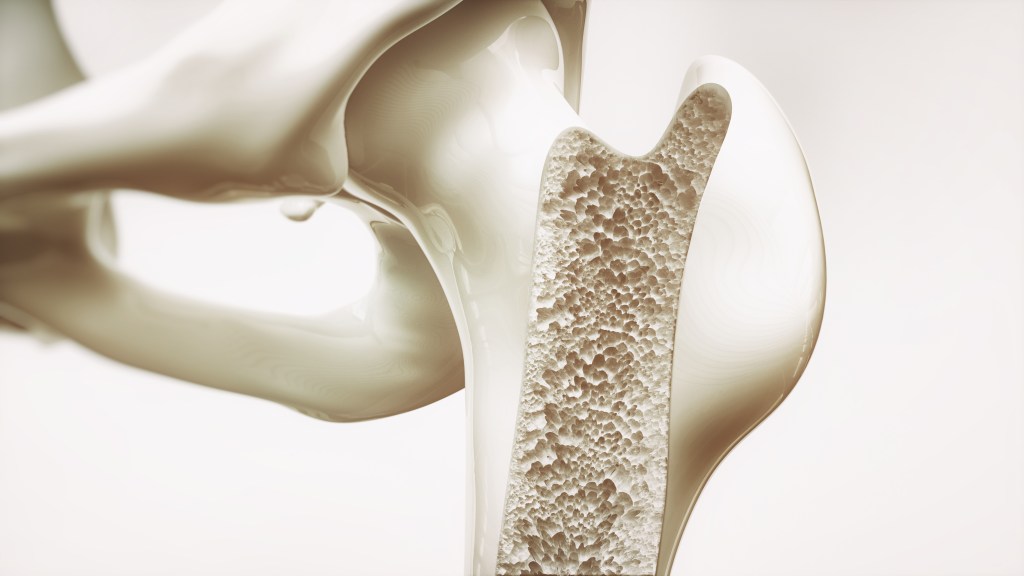Scientists have found a molecular switch buried in your cells that could rewrite the future of bone health. For the first time, researchers can flip this switch on command and watch bones grow stronger, even when they’ve already started to weaken. Even more surprising: exercise appears to amplify the effect.
Your skeleton isn’t the static framework you might imagine. Right now, specialized cells are breaking down old bone while others build new tissue to replace it. For most of your life, these two forces stay balanced. But somewhere around age 50, that balance tips. Breakdown starts winning. Density drops. Fractures become more likely.
Six million people in Germany alone face osteoporosis, a condition where bones become so porous that they can snap under ordinary stress. Current treatments often come with serious side effects or simply stop working after extended use. Doctors have been searching for better options for decades.
Now, a team at Leipzig University in Germany may have found one.
A Receptor Hiding in Plain Sight
Cell surfaces contain thousands of different receptors, protein structures that act like tiny antennas picking up signals from the outside world. G protein-coupled receptors, or GPCRs, function as molecular switches. When the right signal molecule docks with a GPCR, it activates a G protein inside the cell. That single activation can trigger the production of hundreds or even thousands of messenger molecules, setting off cascading effects throughout the cell.
One particular GPCR, called GPR133, had caught researchers’ attention before. Earlier studies linked variations in the GPR133 gene to bone mineral density in humans. Bone mineral density measures the concentration of calcium and phosphorus in your skeleton and serves as a key indicator of bone strength. Low BMD means higher fracture risk, especially in people with osteoporosis.
But knowing GPR133 affected bone density and understanding how it worked were two different problems. Scientists at Leipzig University set out to solve the second one.
Turning Off the Switch

Researchers created mice with the GPR133 gene either completely removed or deleted only in the precursor cells that mature into osteoblasts, the bone-building cells. Results appeared fast. Knockout mice developed thinner bones and lower mineral density than normal mice. Trabecular bone, the spongy tissue inside bones, showed fewer structural supports and wider gaps. Cortical bone, the dense outer shell, grew thinner.
Tests revealed something else: these mice showed classic signs of osteoporosis at ages when their bones should have been strong. Removing GPR133 from just the osteoblast precursor cells produced the same effect, pinpointing where the receptor did its most important work.
Lab experiments with cells told the same story. When researchers switched off GPR133 in bone marrow stem cells and osteoblast precursors, the cells couldn’t mature properly. Markers that signal healthy osteoblast differentiation stayed low. Alkaline phosphatase activity, an enzyme essential for bone mineralization, dropped. Collagen deposition decreased. Calcium deposits that indicate new bone formation barely appeared.
Professor Ines Liebscher, who led the investigation at Leipzig’s Rudolf Schönheimer Institute of Biochemistry, explained the findings: “If this receptor is impaired by genetic changes, mice show signs of loss of bone density at an early age, similar to osteoporosis in humans.”
Two Pathways Working Together
Digging into the molecular details, researchers found GPR133 works through two signaling pathways already known to be essential for bone health: cyclic adenosine monophosphate (cAMP) and β-catenin. When GPR133 activates, it increases cAMP levels inside osteoblasts. Higher cAMP prevents the breakdown of β-catenin, a protein that must accumulate in cells to trigger the genes needed for bone formation.
Without GPR133, both signals fail. β-catenin levels drop because cells degrade it faster than they produce it. Genes that should turn on during osteoblast maturation stay quiet. Bone formation stalls.
Interestingly, the effect rippled beyond osteoblasts. Knockout mice showed increased numbers of osteoclasts, the cells that break down bone. Osteoblasts normally produce a protein called osteoprotegerin that keeps osteoclasts in check. With fewer functional osteoblasts making less osteoprotegerin, osteoclasts became more active. Bone loss accelerated from both sides: less formation and more breakdown.
Physical Force Activates the Receptor

Researchers discovered something unexpected when they applied mechanical strain to cells in lab dishes. Stretching or loading osteoblast precursor cells turned on GPR133. Cells responded by increasing cAMP levels and ramping up differentiation markers.
Different amounts of strain produced different effects. Gentle to moderate stretching (5% to 10% elongation) boosted bone formation markers. Too much force (15% elongation) had the opposite effect, impairing differentiation. Goldilocks apparently applies to bone cells.
GPR133 doesn’t work alone in sensing mechanical forces. It partners with another protein called PTK7, which sits on cell surfaces and helps neighboring cells communicate. When PTK7 binds to GPR133, it helps activate the receptor. Mechanical force and PTK7 interaction work together, creating a stronger signal than either stimulus alone.
Exercise studies in living mice confirmed what cell experiments suggested. Researchers put young mice on treadmills for controlled running sessions, five days per week for four weeks. Running increased bone volume and trabecular number compared to sedentary mice. Combining exercise with a GPR133-activating drug produced even better results, improving all measured bone parameters.
AP503: A Drug That Mimics Natural Activation

Leipzig researchers identified a small-molecule compound called AP503 through computer-assisted screening. AP503 selectively activates GPR133, mimicking what mechanical force and PTK7 do naturally.
Daily injections of AP503 for four weeks increased bone density and strength in both healthy mice and mice with low bone mineral density. Three-point bending tests, which measure how much force bones can withstand before breaking, showed treated bones resisted stress better than untreated ones.
Numbers of osteoblasts and osteocytes (mature bone cells embedded in the bone matrix) increased with treatment. Osteoclast numbers dropped. Bone formation rates, measured by tracking how fast new mineral deposits appear, went up.
Perhaps most importantly, AP503 reversed bone loss in a mouse model designed to mimic postmenopausal osteoporosis. Researchers removed ovaries from female mice, causing the same hormone changes that drive bone loss after menopause in women. Four weeks after surgery, they started daily AP503 injections and continued for another four weeks.
Results were striking. Bone volume, mineral density, cortical thickness, and trabecular structure all improved toward normal levels. Changes in bone cell populations reversed. Mechanical strength returned.
Dr. Juliane Lehmann, the study’s lead author and a researcher at Leipzig’s Biochemistry Institute, noted the broader implications: “The newly demonstrated parallel strengthening of bone once again highlights the great potential this receptor holds for medical applications in an aging population.”
Earlier work from the same lab showed AP503 also strengthens skeletal muscle. Activating GPR133 appears to benefit both tissues simultaneously, which could be particularly valuable for older adults facing both bone loss and muscle wasting.
Your Genes Might Already Tell the Story

Some people carry natural mutations in GPR133. These genetic variations can reduce how well the receptor signals. Studies have linked certain GPR133 variants to differences in bone mineral density across human populations.
People born with less functional versions of GPR133 might face a higher risk for early-onset osteoporosis or greater susceptibility to bone loss triggered by medications, immobility, or medical conditions. Genetic screening could identify these individuals before problems start, opening the door to preventive treatment.
Blood tests from treated mice revealed another clue. Animals with GPR133 knocked out showed elevated calcium levels in their blood. Calcium in the blood comes partly from bone breakdown. When researchers gave these mice AP503 (and the mice still had one working copy of the gene), blood calcium levels dropped back to normal. Less bone was being torn down and released into circulation.
Beyond Osteoporosis

Applications could extend past treating osteoporosis in older adults. Astronauts lose bone density in zero gravity because their skeletons no longer experience the mechanical loading that normally maintains bone strength. GPR133 activation might help counteract this, especially since the receptor responds to mechanical force.
Patients immobilized after surgery or injury also lose bone mass. Cancer treatments and long-term steroid use can trigger secondary osteoporosis. All these situations might benefit from GPR133-targeted therapy.
Because the receptor also affects muscle, it could help people with muscle-wasting conditions or those recovering from extended bed rest.
Questions Remain

Mouse studies provide valuable information, but can’t tell the whole story. Mice and humans differ in bone physiology. Treatments that work in rodents sometimes fail in people.
Long-term safety of AP503 remains unknown. While researchers screened it for specificity to avoid affecting other receptors, questions about side effects, optimal dosing, and how the human body processes the drug need answers. Effects on other organ systems haven’t been explored in detail.
Clinical trials in humans represent the next step. Researchers need to confirm that GPR133 works the same way in human bone cells as it does in mice. They need to verify AP503 is safe and effective across diverse patient populations. They need to test it in people with different types of bone loss.
Leipzig researchers are already working on follow-up projects to explore AP503’s use in various diseases and to investigate GPR133’s roles throughout the body.
A New Tool for Aging Bones
If human trials succeed, GPR133 activation could offer a new class of osteoporosis drugs with potentially fewer side effects than current options. Rather than simply slowing bone loss, this approach actively promotes bone formation by working with the body’s natural bone-building machinery.
Personalized medicine based on GPR133 genetics could identify who needs treatment most. People with fewer functional receptor variants could start preventive therapy before significant bone loss occurs.
After decades of incremental progress in osteoporosis treatment, this discovery offers something different: a molecular target that responds to both drugs and physical activity, that builds muscle while strengthening bones, and that might work even after damage has already occurred. Your skeleton’s hidden switch might finally be within reach.









Leave a Reply